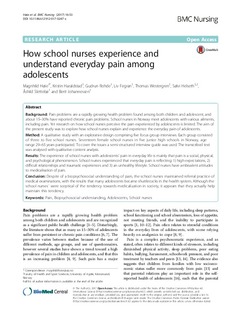| dc.contributor.author | Høie, Magnhild | |
| dc.contributor.author | Haraldstad, Kristin | |
| dc.contributor.author | Rohde, Gudrun E. | |
| dc.contributor.author | Fegran, Liv | |
| dc.contributor.author | Westergren, Thomas | |
| dc.contributor.author | Helseth, Sølvi | |
| dc.contributor.author | Slettebø, Åshild | |
| dc.contributor.author | Johannessen, Berit | |
| dc.date.accessioned | 2018-02-22T09:34:08Z | |
| dc.date.available | 2018-02-22T09:34:08Z | |
| dc.date.created | 2017-10-03T14:39:16Z | |
| dc.date.issued | 2017 | |
| dc.identifier.citation | BMC Nursing, 16:53 2017 | nb_NO |
| dc.identifier.issn | 1472-6955 | |
| dc.identifier.uri | http://hdl.handle.net/11250/2486345 | |
| dc.description.abstract | Background
Pain problems are a rapidly growing health problem found among both children and adolescent, and about 15–30% have reported chronic pain problems. School nurses in Norway meet adolescents with various ailments, including pain. Yet research on how school nurses perceive the pain experienced by adolescents is limited. The aim of the present study was to explore how school nurses explain and experience the everyday pain of adolescents.
Method
A qualitative study with an explorative design comprising five focus group interviews. Each group consisted of three to five school nurses. Seventeen female school nurses in five junior high schools in Norway, age range 29–65 years participated. To cover the issues a semi structured interview guide was used. The transcribed text was analysed with qualitative content analysis.
Results
The experience of school nurses with adolescents’ pain in everyday life is mainly that pain is a social, physical, and psychological phenomenon. School nurses experienced that everyday pain is reflecting: 1) high expectations, 2) difficult relationships and traumatic experiences and 3) an unhealthy lifestyle. School nurses have ambivalent attitudes to medicalisation of pain.
Conclusion
Despite of a biopsychosocial understanding of pain, the school nurses maintained referral practice of medical examinations, with the results that many adolescents became shuttlecocks in the health system. Although the school nurses´ were sceptical of the tendency towards medicalization in society, it appears that they actually help maintain this tendency. | nb_NO |
| dc.language.iso | eng | nb_NO |
| dc.publisher | Biomed Central | nb_NO |
| dc.rights | Navngivelse 4.0 Internasjonal | * |
| dc.rights.uri | http://creativecommons.org/licenses/by/4.0/deed.no | * |
| dc.title | How school nurses experience and understand everyday pain among adolescents | nb_NO |
| dc.type | Journal article | nb_NO |
| dc.type | Peer reviewed | nb_NO |
| dc.description.version | publishedVersion | nb_NO |
| dc.source.volume | 16 | nb_NO |
| dc.source.journal | BMC Nursing | nb_NO |
| dc.source.issue | 1 | nb_NO |
| dc.identifier.doi | 10.1186/s12912-017-0247-x | |
| dc.identifier.cristin | 1501901 | |
| dc.description.localcode | nivå1 | nb_NO |
| cristin.unitcode | 201,18,0,0 | |
| cristin.unitname | Fakultet for helse- og idrettsvitenskap | |
| cristin.ispublished | true | |
| cristin.fulltext | original | |
| cristin.qualitycode | 1 | |

